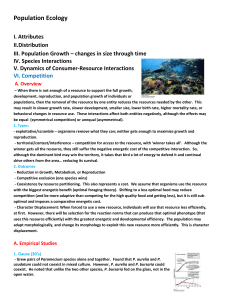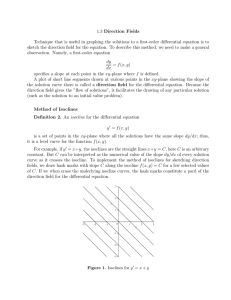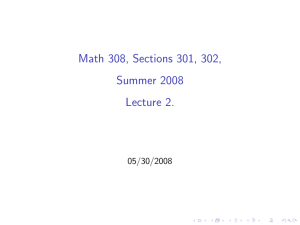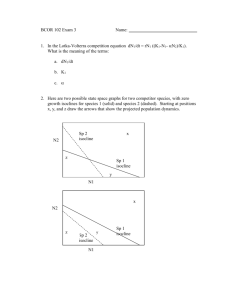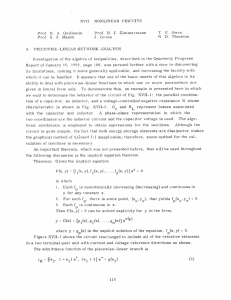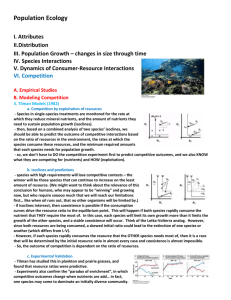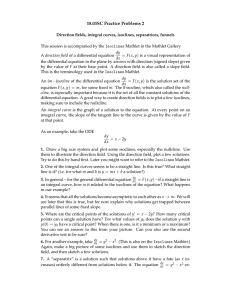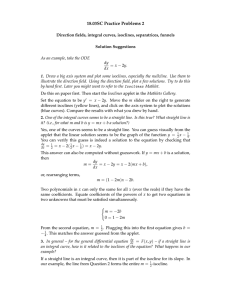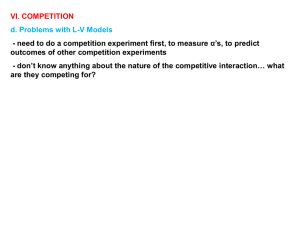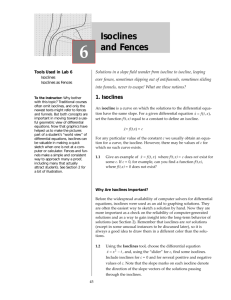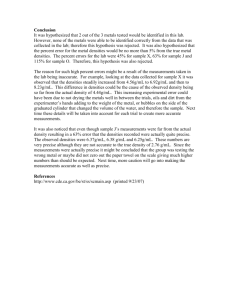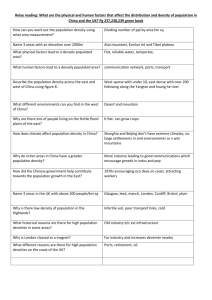Competition I
advertisement
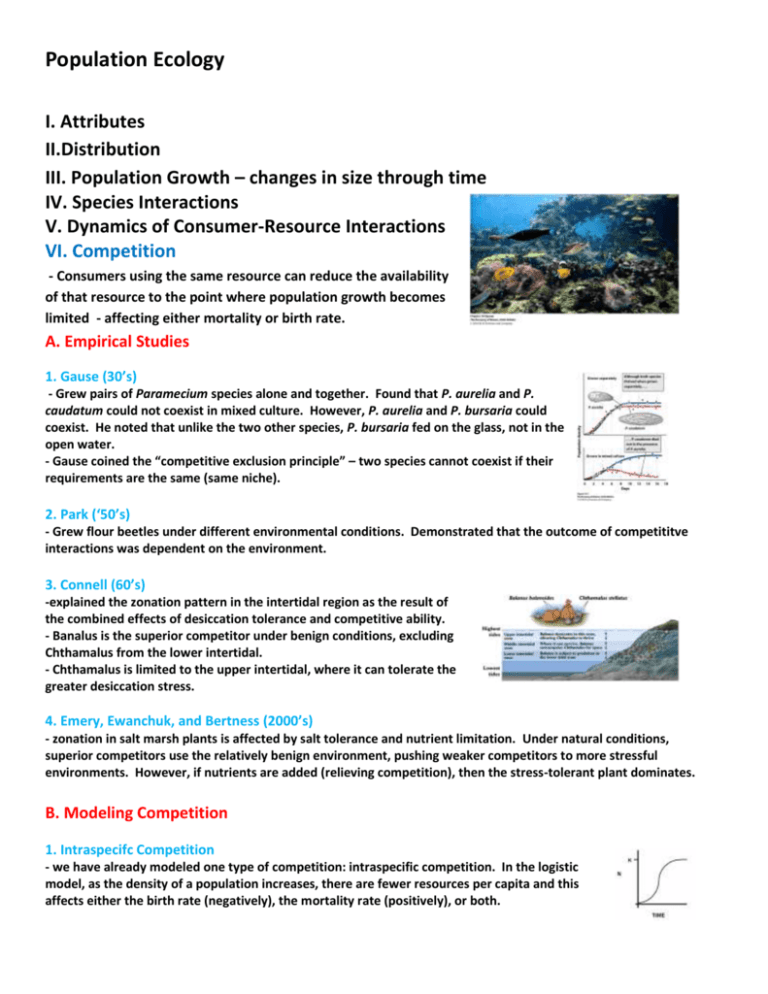
Population Ecology I. Attributes II.Distribution III. Population Growth – changes in size through time IV. Species Interactions V. Dynamics of Consumer-Resource Interactions VI. Competition - Consumers using the same resource can reduce the availability of that resource to the point where population growth becomes limited - affecting either mortality or birth rate. A. Empirical Studies 1. Gause (30’s) - Grew pairs of Paramecium species alone and together. Found that P. aurelia and P. caudatum could not coexist in mixed culture. However, P. aurelia and P. bursaria could coexist. He noted that unlike the two other species, P. bursaria fed on the glass, not in the open water. - Gause coined the “competitive exclusion principle” – two species cannot coexist if their requirements are the same (same niche). 2. Park (‘50’s) - Grew flour beetles under different environmental conditions. Demonstrated that the outcome of competititve interactions was dependent on the environment. 3. Connell (60’s) -explained the zonation pattern in the intertidal region as the result of the combined effects of desiccation tolerance and competitive ability. - Banalus is the superior competitor under benign conditions, excluding Chthamalus from the lower intertidal. - Chthamalus is limited to the upper intertidal, where it can tolerate the greater desiccation stress. 4. Emery, Ewanchuk, and Bertness (2000’s) - zonation in salt marsh plants is affected by salt tolerance and nutrient limitation. Under natural conditions, superior competitors use the relatively benign environment, pushing weaker competitors to more stressful environments. However, if nutrients are added (relieving competition), then the stress-tolerant plant dominates. B. Modeling Competition 1. Intraspecifc Competition - we have already modeled one type of competition: intraspecific competition. In the logistic model, as the density of a population increases, there are fewer resources per capita and this affects either the birth rate (negatively), the mortality rate (positively), or both. 2. Lotka-Volterra Interspecific Competition a. Competition Coefficients: - The presence of another species that is removing resources from the environment will LOWER the density at which our target population will equilibrate. The amount of this decrease depends on the number of competing organisms, and the rate at which they remove resources. If we want to graph this relationship on a graph where our y-axis is N1 (or represent it in equation form), then we need to represent this decline in terms of N1 individuals. This requires a “conversion term”, α, which is the “per capita effect of N2 individuals in terms of N1 individuals”. For example, if 10 N2 individuals causes the population of N1 to equilibrate at a size 20 individuals lower (60 vs. 80, for example), then a = 2; apparently, each of the N2 individuals eats twice as much as an N1 individual, so 10 of them are “exerting the competitive effect” equal to 20 N1 individuals. - So, our logistic model for the growth of species 1 = dN1/dt = r1N1 ((K1 – N1 – αN2)/K1) - And Likewise, the equation for species 2 = dN2/dt = r2N2 ((K2 – N2 – αN1)/K2) b. Isoclines - So, when species 1 is alone (N2 = 0), it grows to its carrying capacity of N1 = 80. When there are 10 individuals of N2, N1 equilibrates at 60. When there are 20 N2 individuals, N1 equilibrates at 40; when there are 30 N2 individuals, N1 equilibrates at 20; and when there are 40 N2 individuals, each eating as much as 2 N1’s, then they exert a competitive effect equal to 80 N1 individuals and there is no food left for N1 individuals to eat. So, when N2 = 40, species 1 is competitively excluded (N1 = 0). - Now, we can plot each of these equilibrium points in terms of N1 and N2 densities. These points form a line, called an isocline. Anywhere along this isocline, dN1/dt = 0. Above the isocline, N1 will decrease. Below the isoclines, N1 will increase. c. Dynamics - We can plot the isoclines of both species on the same graph, and see how the species both change in response to the competitive interactions between them. If one isocline is completely above the other, then this species will be able to continue to increase even after the other has reached its isoclines an equilibrated. Hmmm… but if this species continues to increase, it will impose a progressively greater competitive effect on the equilibrated species. Yes…meaning that the equilibrated species will decline, and equilibrate at a new lower level. But even here, the other species can continue to increase. Eventually, the species with the lower isoclines is competitively excluded from the environment. - If the isoclines cross, then there is a point (intersection) where both species equilibrate at non-zero values. This means that both species can exist in the environment – this is coexistence. So, competitive exclusion is not the ONLY result that competition can produce, as we saw in the empirical studies. -Look along the axis of each species. If each species reaches its K before it reaches k/α, then it will reach its own carrying capacity (K) before it can reach a density at which it would competitively exclude the other species (K/α). So, this dynamic will converge on coexistence – both species will persist because neither can exclude the other – they are limited more by their own densities and the environment than by the other species. - However, if each species can reach K/α before it reaches its own K, then the coexistence is unstable. A shift in densities off the equilibrium will give an advantage to one or the other species, which will drive the second species to extinction. d. Problems with the L-V Models - not totally predictive in the case of two species; you have to do the competition experiment to define the α’s under one condition. Then you could make predictions about the results at other densities. - The nature of the competitive interaction is undefined… what are they competing for? Study Questions: 1) What is the competitive exclusion principle, and how did the results from Gause’s experiments lead him to this conclusion? 2) What were the important nuances to competition revealed by the experiments of Park, Connell, and Emery? 3) Write the L-V equations for two competing species. 4) Define αN2 5) Consider the figures, below. State what the outcome will be if the initial densities are as indicated (red dot), and explain why in terms of isoclines and the rates of growth of the two populations.
